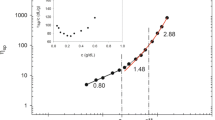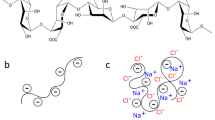Abstract
Ultra-high viscosity alginates were extracted from the brown seaweeds Lessonia nigrescens (UHVN, containing 61% mannuronate (M) and 2% guluronate (G)) and Lessonia trabeculata (UHVT, containing 22% M and 78% G). The viscoelastic behavior of the aqueous solutions of these alginates was determined in shear flow in terms of the shear stress σ 21, the first normal stress difference N 1, and the shear viscosity η in isotonic NaCl solutions (0.154 mol/L) at T = 298 K in dependence of the shear rate \(\dot{\gamma}\) for solutions of varying concentrations and molar masses (3–10 × 105 g/mol, homologous series was prepared by ultrasonic degradation). Data obtained in small-amplitude oscillatory shear (SAOS) experiments obey the Cox–Merz rule. For comparison, a commercial alginate with intermediate chemical composition was additionally characterized. Particulate substances which are omnipresent in most alginates influenced the determination of the material functions at low shear rates. We have calculated structure–property relationships for the prediction of the viscosity yield, e.g., η–M w–c–\(\dot{\gamma}\) for the Newtonian and non-Newtonian region. For the highest molar masses and concentrations, the elasticity yield in terms of N 1 could be determined. In addition, the extensional flow behavior of the alginates was measured using capillary breakup extensional rheometry. The results demonstrate that even samples with the same average molar mass but different molar mass distributions can be differentiated in contrast to shear flow or SAOS experiments.










Similar content being viewed by others
References
Bazilevskii AV, Entov VM, Rozhkov AN (2001) Breakup of an Oldroyd liquid bridge as a method for testing the rheological properties of polymer solutions. Polym Sci Ser A 43:716–726
Böhm N, Kulicke W-M (1999) Rheological studies of barley (1–3)(1–4)-beta-glucan in concentrated solution—II. Mechanistic and kinetic investigation of the gel formation. Carbohydr Res 315:293–301
Bouldin M, Kulicke W-M, Kehler H (1988) Prediction of the non-Newtonian viscosity and shear stability of polymer solutions. Coll Polym Sci 266:793–805
Castelain C, Doublier JL, Lefebvre J (1987) A study of the viscosity of cellulose derivatives in aqueous solutions. Carbohydr Polym 7:1–16
Cox WP, Merz EH (1958) Correlation of dynamic and steady flow viscosities. J Polym Sci 28:619–622
de Vos P, Faas MM, Strand B, Calafiore R (2006) Alginate-based microcapsules for immunoisolation of pancreatic islets. Biomaterials 27:5603–5617. doi:10.1016/j.biomaterials.2006.07.010
Donati I, Holtan S, Morch YA, Borgogna M, Dentini M, Skjak-Brak G (2005) New hypothesis on the role of alternating sequences in calcium-alginate gels. Biomacromolecules 6:1031–1040
Entov VM, Hinch EJ (1997) Effect of a spectrum of relaxation times on the capillary thinning of a filament of elastic liquid. J Non-Newton Fluid Mech 72:31–53
Ferry JD (1980) Viscoelastic properties of polymers, 3rd edn. Wiley, New York
Ferry JD, Lande1 RL, Williams ML (1955) Extension of the Rouse theory of viscoelastic properties to undiluted linear polymers. J Appl Phys 26:359–362
Gahleitner M, Sobczak M (1989) Significance of zero viscosity determination for the modeling of flow curves. Kunststoffe 79:1213–1216
Grasdalen H, Larsen B, Smidsrød O (1979) A P.M.R. study of the composition and sequence of uronate residues in alginate. Carbohydr Res 68:23–31
Graessley WW (1965) Molecular entanglement theory of flow behavior in amorphous polymers. J Chem Phys 43:2696–2703
Graessley WW (1967) Viscosity of entangling polydisperse polymers. J Chem Phys 47:1942–1953
Graessley WW (1974) The entanglement concept in polymer rheology. Adv Polym Sci 16:1–179
Graessley WW (1980) Polymer chain dimensions and the dependence of viscoelastic properties on concentration, molecular weight, and solvent power. Polymer 21:258–262
Hashemzadeh A, Kulicke WM (1986) Degradation von Polymer-molekülen beim Durchströmen poröser Medien. Chem-Ing Tech 58:325–327
Hoffman AS (2002) Hydrogels for biomedical applications. Adv Drug Deliv Rev 54:3–12
Kniewske R, Kulicke W-M (1983) Study on the molecular weight dependence of dilute properties of narrowly distributed polystyrene in toluene and in the unperturbed state. Makromol Chem 184:2173–2186
Kühtreiber WM, Lanza RP, Chick WL (1999) Artificial pancreas. In: Kuhtreiber WM, Lanza RP, Chick WL (eds) Encapsulated cell technology and therapeutics. Birkhäuser, Boston, pp 217–228
Kulicke W-M, Clasen C (2004) Viscosimetry of polymers and polyelectrolytes. Springer, Berlin
Kulicke W-M, Kniewske R (1984) The shear viscosity dependence on concentration, molecular weight, and shear rate of polystyrene solutions. Rheol Acta 23:75–83
Kulicke W-M, Kniewske R, Klein J (1982) Preparation, characterization, solution properties and rheological behavior of polyacrylamides. Prog Polym Sci 8:373–468
Kulicke WM, Kniewske R, Müller RJ, Prescher M, Kehler H (1986) Scherung und Degradation von Polymerlösungen. Angew Makromol Chem 142:29–49
Kulicke W-M, Otto M, Baar M (1993) Improved NMR characterization of high-molecular-weight polymers and polyelectrolytes through the use of preliminary ultrasonic degradation. Macromol Chem Phys 194:751–765
Kulicke W-M, Kull AH, Kull W, Thielking H, Engelhardt J, Pannek J-B (1996) Characterization of aqueous carboxymethylcellulose solutions in terms of their molecular structure and its influence on rheological behavior. Polymer 37:2723–2731
Kulicke W-M, Clasen C, Lohmann C (2005) Characterization of water-soluble cellulose derivatives in terms of the molar mass and particle size as well as their distribution. Macromol Symp 223:151–174
Lanza RP, Langer R, Vacanti J (2000) Principles of tissue engineering, 2nd edn. Academic, San Diego
Li L, Fang Y, Vreeker R, Appelqvist I, Mendes E (2007) Reexamining the egg-box model in calcium-alginate gels with X-ray diffraction. Biomacromolecules 8:464–468
Liew CV, Chan LW, Ching AL, Heng PWS (2006) Evaluation of sodium alginate as drug release modifier in matrix tablets. Int J Pharm 309:25–37
Manz B, Hillgärtner M, Zimmermann H, Zimmermann D, Volke F, Zimmermann U (2004) Cross-linking properties of alginate gels determined by using advanced NMR imaging and Cu2+ as contrast agent. Eur Biophys J 33:50
Matsumoto T, Mashiko K (1990) Viscoelastic properties of alginate aqueous-solutions in the presence of salts. Biopolymers 29:1707–1713
Matsumoto T, Kawai M, Masuda T (1992) Influence of chain stiffness on the gelation and gel structure of alginate aqueous systems. Chem Soc Farad Trans 18:2673–2676
Morris ER, Rees DA, Thom DJ (1973) Characterization of polysaccharide structure and interactions by circular dichroism. Order-disorder transition in the calcium alginate system. Chem Soc Chem Comm 7:245–246
Morris ER, Rees DA, Thom D, Boyd J (1978) Chiroptical and stoichiometric evidence of a specific, primary dimerization process in alginate gelation. Carbohydr Res 66:145–154
Oertel R, Kulicke W-M (1991) Viscoelastic properties of liquid crystals of aqueous biopolymer solutions. Rheol Acta 30:140–150
Plog JP, Clasen C, Kulicke W-M (2005) Influence of the molar mass distribution on the elongational behavior of polymer solutions in capillary breakup. Appl Rheol 15:28–37
Rouse PE (1953) A Theory of the linear viscoelastic properties of dilute solutions of coiling polymers. J Chem Phys 21:1272–1280. doi:10.1063/1.1699180
Schittenhelm N, Kulicke W-M (2000) Producing homologous series of molar masses for establishing structure–property relationships with the aid of ultrasonic degradation. Macromol Chem Phys 201:1976–1984
Simha R, Zakin JL (1962) Solution viscosities of linear, flexible, high polymers. J Colloid Sci 17:270
Smidsrød O, Haug A, Lian B (1972) Properties of poly(1,4-hexuronates) in the gel state. Acta Chem Scand 26:71–78
Stelter M, Brenn B, Yarin AL, Singh RP, Durst F (2002) Investigation of the elongational behavior of polymer solutions by means of an elongational rheometer. J Rheol 46:507–527
Storz H, Müller K, Ehrhart F, Gómez I, Shirley SG, Gessner P, Zimmermann G, Weyand E, Sukhorukov VL, Forst T, Weber MM, Zimmermann H, Kulicke W-M, Zimmermann U (2009) Physicochemical features of ultra-high viscosity alginates. Carbohydr Res 344:985–995. doi:10.1016/j.carres.2009.02.016
Takahashi Y, Yoshinobo I, Noda IN (1985) Zero-shear viscosity of linear polymer solutions over a wide range of concentration. Macromolecules 18:1002–1008
Tønnesen HH, Karlsen J (2002) Alginate in drug delivery systems. Drug Dev Ind Pharm 28:621–630
Vermeulen H, Ubbink DT, Goossens A, de Vos R, Legemate DA (2005) Systematic review of dressings and topical agents for surgical wounds healing by secondary intention. Br J Surg 92:665–672
Wang ZY, Zhang QZ, Konno M, Saito S (1994) Sol–gel transition of alginate solution by the addition of various divalent cations: a rheological study. Biopolymers 34:737–746
Weber M, Steinert A, Jork A, Dimmler A, Schütze N, Thürmer F, Hendrich C, Zimmermann U (2002) Formation of cartilage matrix proteins by BMP-transfected murine mesenchymal stem cells encapsulated in a novel class of alginates. Biomaterials 23:2001–2013
Yasuda K, Armstrong RC, Cohen RE (1981) Shear flow properties of concentrated solutions of linear and star branched polystyrenes. Rheol Acta 20:163–178
Zekorn TD, Horcher A, Siebers U, Fedewrlin K, Bretzel RG (1999) Synergistic effect of microencapsulation and immunoalteration on islet allograft survival in bioartificial pancreas. J Mol Med 77:193–198
Zimmermann U, Mimietz S, Zimmermann H, Hillgärtner M, Schneider H, Ludwig J, Hasse C, Hasse A, Rothmund M, Fuhr G (2000) Hydrogel-based non-autologous cell and tissue therapy. Biotechniques 29:564–581
Zimmermann H, Zimmermann D, Reuss R, Feilen PJ, Manz B, Katsen A, Weber M, Ihmig FR, Ehrhart F, Gessner P, Behringer M, Steinbach A, Wegner LH, Sukhorukov VL, Vasquez JA, Schneider S, Weber MM, Volke F, Wolf R, Zimmermann U (2005) Towards a medically approved technology for alginate-based microcapsules allowing long-term immunoisolated transplantation. Mater Sci Mater Med 16:491–501
Zimmermann H, Wählisch F, Baier C, Westhoff M, Reuss R, Zimmermann D, Behringer M, Ehrhart F, Katsen-Globa A, Giese C, Marx U, Sukhorukov VL, Vásquez JA, Jakob P, Shirley SG, Zimmermann U (2007b) Biomaterials 28:1327–1345. doi:10.1016/j.biomaterials.2006.11.032
Zimmermann H, Ehrhart F, Zimmermann D, Muller K, Katsen-Globa A, Behringer M, Feilen PJ, Gessner P, Zimmermann G, Shirley SG, Weber MM, Metze J, Zimmermann U (2007c) Hydrogel-based encapsulation of biological, functional tissue: fundamentals, technologies and applications. Appl Phys A 89:909–922
Acknowledgements
We are very grateful to F. Bauer for the performance of the encapsulation experiments. This work was supported by grants of the Bundesministerium für Wirtschaft und Technologie (AIF KF0054-702WZ7) awarded to U. Z. and of the Bundesministerium für Bildung und Forschung (PTJ μAirjet 0313680B) awarded to H.Z.
Author information
Authors and Affiliations
Corresponding author
Rights and permissions
About this article
Cite this article
Storz, H., Zimmermann, U., Zimmermann, H. et al. Viscoelastic properties of ultra-high viscosity alginates. Rheol Acta 49, 155–167 (2010). https://doi.org/10.1007/s00397-009-0400-x
Received:
Accepted:
Published:
Issue Date:
DOI: https://doi.org/10.1007/s00397-009-0400-x




